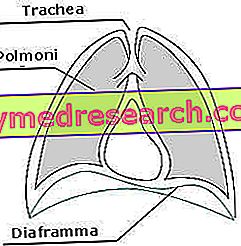Generality
Bladder exstrophy is the rare congenital malformation of the bladder, so that the latter is exposed on the outer wall of the abdomen, open (instead of being a closed organ) and upside down (ie with the mucosa outside rather than inside ).

A cause of bladder exstrophy is an error in fetal development processes that lead to the correct formation of the lower abdominal wall. In patients with bladder exstrophy, in fact, there is a lack of closure of the lower abdomen.
Diagnosed before birth, bladder exstrophy always requires surgical therapy with reparative / reconstructive purposes.
What is bladder exstrophy?
Bladder exstrophy is the congenital defect of the urinary system, in the presence of which the bladder is: exposed on the outer wall of the abdomen, open and upside down.
Bladder exstrophy is, therefore, a malformation of the bladder present from birth (meaning "congenital"), in which the urinary organ in question is:
- Visible on the external abdominal wall,
- Not reclosed on itself e
- With the outside the mucosa that should reside inside (meaning "upside down").
Bladder exstrophy belongs to the pathological category called " complex bladder exstrophy - epispadias ", to which epispadias and cloacal exstrophy also belong.
In medicine, the term " exstrophy " refers to the malformation of an internal hollow organ, such that the latter is outside the human body (generally of the abdomen) and has the mucous membrane on the outside which should cover its inner surface .
Bladder exstrophy is a decidedly rare congenital defect; to be born with bladder exstrophy, in fact, is one person every 20, 000-50, 000.
For reasons that are still unknown, bladder exstrophy is decidedly more frequent in the male population than in the female population; in this regard, the statistics say that for every single female with bladder exstrophy there are from 3 to even 6 males with the same congenital anomaly (ratio 3-6: 1 in favor of male individuals).
Still for reasons yet to be clarified, bladder exstrophy has a predilection for white individuals.
Among the congenital defects that fall within the so-called complex bladder exstrophy - epispadia, bladder exstrophy is the most common and that of intermediate gravity.
Synonyms
Bladder exstrophy has several synonyms, including: bladder ectopia, exposed bladder and bladder exstrophy .
Causes
The cause of bladder exstrophy is the failure, during fetal development, of the formation and closure of the lower abdominal wall.
In fact, for the fetus, the correct process of forming and closing the lower abdominal wall is essential to complete the anatomy of the underlying internal organs.

Hypothesis on the Causes of Bladder Exstrophy
On the basis of the scientific researches conducted so far, it seems that the lack of fetal development of the lower abdominal wall is due to an error in the process of evolution of the cloacal membrane, between the IV and the VI week following conception.
If this were the case, then, bladder exstrophy would be a very early congenital defect, that is, that occurs in the very early stages of human embryogenesis.
Curiosity
Recent studies, all still to prove, suggest that:
- The ISL1 gene would be a susceptibility gene for bladder exstrophy. In genetics, a susceptibility gene is a gene suspected of having a pivotal role in the appearance of certain diseases or conditions.
- Bladder exstrophy would be related to environmental factors, such as: the mother's advanced age, assisted reproduction, the use of progesterone by the mother during pregnancy and smoking during pregnancy.
Bladder exstrophy and inheritance
Currently, there is insufficient evidence to support the thesis that bladder exstrophy has a hereditary origin .
However, it is a fact that, often, people born with bladder exstrophy:
- They belong to families, in which there is a certain recurrence of the defects belonging to the complex bladder exstrophy - epispadias;
- They are more likely than other healthy people to give birth to children with malformations similar to theirs.
Risk factors
Risk factors for bladder exstrophy include:
- Family history. As stated earlier, bladder exstrophy appears to be an inheritable defect;
- The white race;
- The male sex.
Symptoms and Complications
Accomplices the anatomical anomalies for which it is responsible, bladder exstrophy compromises the functioning of the bladder ; in those born with bladder exstrophy, in fact, the bladder is not able to accumulate urine or even expel it properly, which triggers a condition of urinary incontinence and urination problems .
Curiosity
In bladder exstrophy, the inability to expel urine is due to a malformed bladder neck and the lack of an effective bladder sphincter (NB: the bladder sphincter is the muscle that serves to get urine out of the bladder).
Additional features
Almost always, to bladder malformation, bladder exstrophy adds other anatomical abnormalities, such as:
- Abnormal union of ureters with bladder. In individuals with bladder exstrophy, the ureters are often joined to the bladder at a point other than normal;
- The separation of the pubic bones of the pelvis. In healthy individuals, the right pubis merges with the left pubis, giving rise to a joint called the pubic symphysis;
- The navel in a lower position than normal;
- The anus in a more advanced position than normal;
- The presence of inguinal or umbilical hernias ;
- In males, the failure of testicles to descend into the scrotum ( cryptorchidism );
- In females, the presence of a poorly placed vaginal orifice and narrower than normal, of the so-called bifid clitoris and of large and small divergent lips .
Patients with bladder exstrophy can present one, only some or all of these additional anomalies; as can be guessed, the more the anomalies in addition to those of the bladder, the greater the degree of severity of bladder exstrophy.
Associated Conditions
In males almost always and in females only in some cases, bladder exstrophy is associated with epispadias. Representing the less serious condition of the so-called complex bladder exstrophy - epispadias, the epispadias is the congenital malformation of the urethra, such that the latter, aided by its inadequate development, ends in a different place from the normal.
Complications
Epidemiological studies have shown that those born with bladder exstrophy present, at adult age, a greater risk of bladder cancer and suffering from sexual dysfunctions .
Diagnosis
Bladder exstrophy is a malformation that can almost always be diagnosed before birth, because fetal ultrasound scans allow it to be identified quite easily.
However, however, bladder exstrophy is clearly visible at birth.
How to recognize Bladder Extrophy with the Ultrasound Examination?
In a fetal ultrasound, they are characteristic signs of bladder exstrophy:
- The inability of the bladder to fill and / or empty properly;
- The umbilical cord positioned lower than normal;
- The separation of the pubic bones of the pelvis;
- The presence of genitals smaller than normal.
Birth assessments in subjects with bladder exstrophy
In order to establish the characteristics of bladder exstrophy, doctors evaluate newborn patients:
- The degree of opening of the bladder and the degree of protrusion on the lower abdominal surface;
- The position of the testicles;
- The presence or not of an inguinal hernia;
- The anatomy of the area around the navel;
- The anatomy of the anus;
- What is the degree of separation of the two pubic bones of the pelvis.
Therapy
The presence of bladder exstrophy requires reconstructive surgery .
The methods of surgery vary from patient to patient and depend on the severity of the malformation present.
A mild bladder exstrophy (in which the anomalies are few and not marked) needs a definitely less "demanding" intervention than a medium-severe grade bladder exstrophy (in which the anatomical alterations are conspicuous and deep).
The main objectives of surgical therapy against bladder exstrophy are:
- Close the bladder (so that it can contain urine), place it inside the abdomen and seal the lower abdominal surface;

- Reconstruct, trying to give them a normal appearance and at least partially restore their function, those organs and those malformed anatomical parts (eg, genitals; urethra in case of epispadias; etc.), which may accompany bladder abnormalities;
- Reconstruct / restore the bladder sphincter in the bladder neck.
Two examples of Therapeutic Approaches for less severe cases and severe cases
THERAPEUTIC APPROACH FOR LESS SERIOUS CASES
For the less severe cases of bladder exstrophy, the treatment involves only one surgical operation, to be carried out generally in the third month of the patient's life.
In practice, the aforementioned intervention usually consists of:
- Closure of the bladder and its housing inside the abdominal cavity;
- Closure of the abdomen;
- Repair of small anomalies present.
When is bladder exstrophy mild?
Bladder exstrophy is to be considered mild when: the quality of the bladder is good, despite the malformation against it, and the accompanying anomalies are barely mentioned, if not entirely absent.
THERAPEUTIC APPROACH FOR SERIOUS CASES
For severe cases of bladder extraction, surgical treatment involves 3 operations :
- An operation 72 hours after birth, in which the doctor closes the bladder, positions it in the abdomen and seals the abdomen;
- An operation between 6 and 12 months of life, in which the surgeon repairs / reconstructs structures such as the urethra and organs such as the genitals;
- An operation between the fourth and sixth years of life (ie when the patient is in age to use the potty), in which the surgeon reconstructs the bladder neck and repairs the bladder sphincter, so that the patient can control the bladder expulsion.
When is bladder exstrophy severe?
Bladder exstrophy is to be considered mild when: the anatomy of the bladder is severely impaired and when there are marked abnormalities of genitals, anus, navel, urethra, etc.
Post-operative phase
After each surgical operation for the management of bladder exstrophy, an immobilization period is foreseen, the duration of which varies according to the age of the patient and the invasiveness of the operation, and whose implementation is fundamental to obtain maximum results from therapy.
For newborns, immobilization can range from 3 to 6 weeks; for slightly older patients and those undergoing invasive procedures (due to serious abnormalities), immobilization can last up to 8 weeks.
Post-operative pain management
Thanks to advances in medicine, today there is a very effective technique to better manage the pain that comes from bladder extraction operations.
The technique in question involves the insertion, at the level of the spinal cord, of a special catheter and the use of this instrument to administer analgesics and anesthetics for a period of time of up to 30 days.
This new technique for pain management, therefore, guarantees a long-term analgesic action, in order to effectively alleviate the suffering of small patients.
Special cases
For some cases of bladder exstrophy, the therapeutic approaches described above are unsuitable or may undergo minor variations, depending on the difficulties that could arise from a certain type of operation.
For example, in some circumstances, reconstruction of the bladder neck and bladder sphincter is impossible, and this requires the use of bladder catheterization .
Adult surgery: when is it needed?
Sometimes, the treatment of bladder exstrophy continues even in more adult age, always with reconstructive surgery and always with the intent to improve the functionality of the bladder and of any other organs that were malformed at birth.
Prognosis
Today, thanks to advances in reconstructive surgery over the last 15 years, the chances of bladder exstrophy having a benign prognosis are far superior to the past.
What affects the effectiveness of the therapy?
The severity of malformations has a decisive influence on the degree of success of surgical therapy for the management of bladder exstrophy; in fact, the more the bladder exstrophy is serious, the more the benefits deriving from its treatment could be partial.
Prevention
Bladder exstrophy is an impossible condition to prevent.



